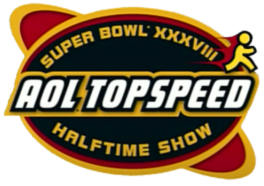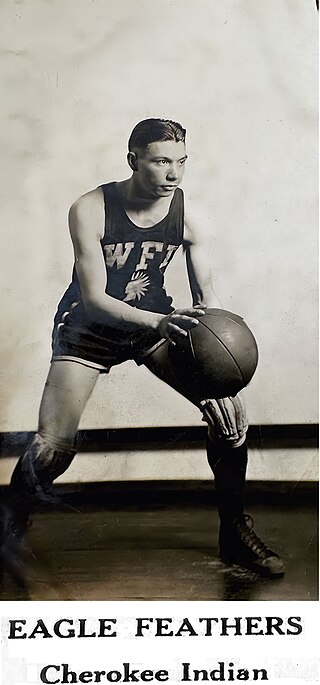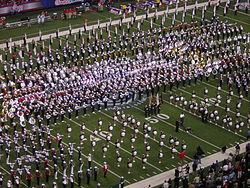
LaRue, sometimes written as La Rue, is a village in Marion County, Ohio, United States. The population was 676 at the 2020 census. The village is served by Elgin Local School District. LaRue has a public library, a branch of Marion Public Library.

The Airedale Terrier, also called Bingley Terrier and Waterside Terrier, is a dog breed of the terrier type that originated in the valley (dale) of the River Aire, in the West Riding of Yorkshire, England. It is traditionally called the "King of Terriers" because it is the largest of the terrier breeds. The Airedale was bred from the Old English Black and Tan Terrier and the Otterhound and probably some other Terrier breeds, and has contributed to other dog breeds, such as the Yorkshire Terrier.

The Oorang Indians were a traveling team in the National Football League from LaRue, Ohio. The franchise was a novelty team put together by Walter Lingo to market his Oorang dog kennels. All of the Indians players were Native American, with Jim Thorpe serving as its leading player and coach. The team played in the National Football League in 1922 and 1923. Of the 20 games they played over two seasons, only one was played at "home" in nearby Marion. With a population well under a thousand people, LaRue remains the smallest town ever to have been the home of an NFL franchise, or probably any professional team in any league in the United States.

Super Bowl XXXVIII was an American football game between the National Football Conference (NFC) champion Carolina Panthers and the American Football Conference (AFC) champion New England Patriots to decide the National Football League (NFL) champion for the 2003 season. The Patriots defeated the Panthers by a score of 32–29. The game was played at Reliant Stadium in Houston, Texas, on February 1, 2004. At the time, this was the most watched Super Bowl ever with 89.8 million viewers.

The Michigan Marching Band is the official marching band of the University of Michigan. The band performs at all Michigan Wolverines football home games, select away games, and numerous concerts, pep rallies, and parades. A student musical ensemble, the MMB evolved from the original Michigan Band of twenty-two players in 1896 to today's band of over 400 members.

The Super Bowl XXXVIII halftime show, known through corporate sponsorship as the Super Bowl XXXVIII AOL TopSpeed Halftime Show took place on February 1, 2004, at the Reliant Stadium in Houston, Texas, as part of Super Bowl XXXVIII. It featured Janet Jackson, Justin Timberlake, P. Diddy, Nelly, Kid Rock, and Jessica Simpson.

The Marching Hundred is the marching band of Indiana University. The Marching Hundred is the product of tradition dating back to the organization of the first band at Indiana in 1896, which was founded to provide recreation for interested students. The 22-piece band of 1896 grew to 47 members by 1913. The current band performs at all home Indiana Hoosiers football games, one away game, several campus events, and bowl game appearances. Toward the end of each season, the Marching Hundred holds an annual Showcase Concert in Indiana University's Assembly Hall. The Marching Hundred is the recipient of the 2007 Sudler Trophy. In 2012, the Marching Hundred performed a five-minute pregame show at Super Bowl XLVI.
Although the Super Bowl is consistently one of the most watched television programs in the United States annually, broadcasters have sometimes attempted to intentionally counterprogram against it by running new programming against the game as an alternative, such as special episodes of existing series, one-off special presentations, and previews of new series, typically during its halftime break.
Walter Lingo was an Airedale Terrier breeder from La Rue, Ohio. During the 1920s, he owned the Oorang Dog Kennels. As a way of promoting his kennels, Lingo financed a National Football League franchise, called the Oorang Indians in 1922.

Nicholas Anthony Lassa, more popularly referred to as Long Time Sleep, was a professional American football player from the Flathead Indian Reservation in Montana.

Pedro "Pete" Calac was a professional football player who played in the Ohio League and during the early years of the National Football League (NFL). Over the course of his 10-year career he played for the Canton Bulldogs, Cleveland Indians, Washington Senators, Oorang Indians and the Buffalo Bisons.

Elmer Eugene "Pete" Busch was a professional football player with the Oorang Indians of the National Football League in 1922. He was a Native American member of the Pomo tribe. He played his college football at the Carlisle Indian School. In 1973, Busch was inducted into the American Indian Hall of Fame.
Ted Lone Wolf was a professional football player during the early years of the National Football League. He grew up and attended high school in his hometown of Flandreau, South Dakota. During his two-year career, Ted played in eleven games with the Oorang Indians. He played in seven games for the 1922 season and in four games for the 1923 season. Ted ended his professional career after the Indians disbanded in 1923.
Alex Bobidosh was a professional football player. He played in one game in the National Football League (NFL) during the 1922 season with the Oorang Indians. The Indians were a team based in LaRue, Ohio, composed only of Native Americans, and coached by Jim Thorpe.

The Super Bowl LII Halftime Show took place on February 4, 2018, at U.S. Bank Stadium in Minneapolis, Minnesota, as part of Super Bowl LII. Justin Timberlake was the featured performer, as confirmed by the National Football League (NFL) on October 22, 2017. It was televised nationally by NBC with a total of 106.6 million television viewers, down 9% from the previous years' Super Bowl LI halftime show.

The World Famous Indians were a basketball team that played exhibition games on tour (barnstorming) in the United States during the 1920s. Among their opponents were the Buffalo Silents of Buffalo, New York, a team whose members were deaf and/or mute.

The Super Bowl XXXVI Halftime Show, known through corporate sponsorship as the E-Trade Super Bowl XXXVI Halftime Show, was the halftime entertainment of Super Bowl XXXVI, which took place on February 3, 2002, at the Louisiana Superdome in New Orleans, Louisiana. It featured Irish rock band U2 as the performer. Using a heart-shaped stage replicated from their 2001 Elevation Tour, the group played three songs and paid tribute to the victims of the September 11 attacks, which had occurred in the United States five months earlier. The show was produced by Clear Channel Entertainment, which also produced the band's Elevation Tour. The Super Bowl and its halftime show were televised nationally in the US by Fox.

The Super Bowl XLI halftime show took place on February 4, 2007 at Dolphin Stadium in Miami Florida as part of Super Bowl XLI. It was headlined by Prince.
The Super Bowl is the annual championship game of the National Football League (NFL). The organization Up with People performed in five Super Bowl halftime shows, and additionally performed in one Super Bowl pre-game show. In addition, in one of the years that they performed as the halftime headliners, Up with People accompanied Tom Sullivan in performing "The Star-Spangled Banner" before the game. Up with People has performed in more Super Bowl halftime shows and had more overall Super Bowl performances than any other act.















